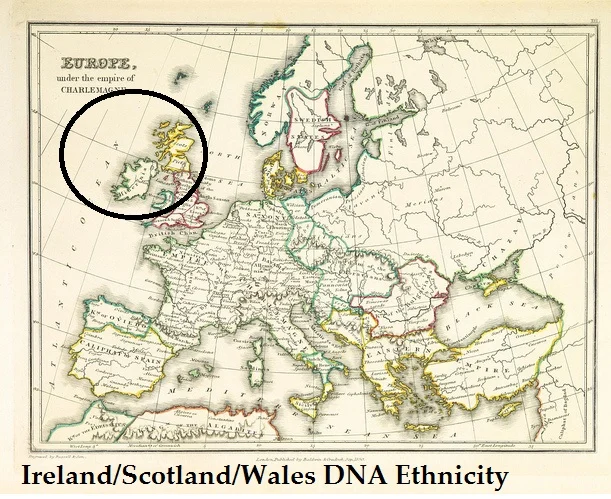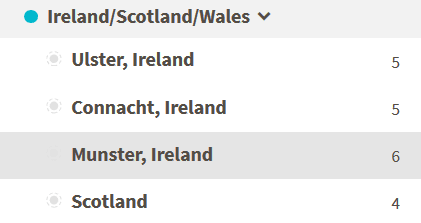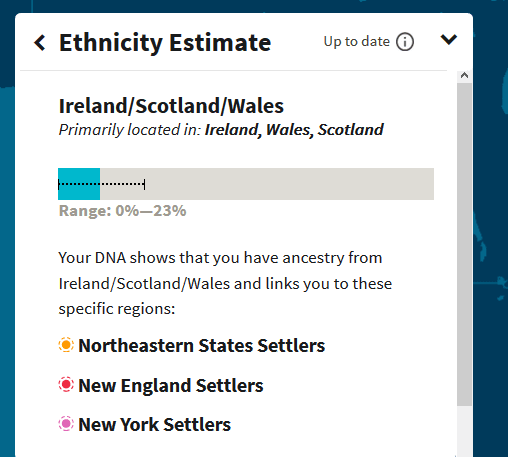Did you find the Ireland/Scotland/Wales DNA ethnicity region in your Ancestry DNA results? You might have known that you had distant Irish roots, or recent Scottish ancestry. Or maybe you are completely shocked to find the Ireland/Scotland/Wales ethnicity in your ethnicity estimate.
In order to truly understand this ethnicity, and how it ended up in your results, we'll have to explore geography, history, and genetics.
In this post, you will learn:
- Where to find the Ireland/Scotland/Wales DNA region on a map
- Which countries typically have the most Irish, Scottish, or Welsh DNA
- Why Ancestry DNA has chosen to combine the Ireland/Scotland/Wales regions, instead of listing them separately
- Whether Ancestry can tell you, specifically, if you have only Irish DNA
- If the Ireland/Scotland/Wales DNA ethnicity can be found in other parts of Europe
- Ideas as to how the Ireland/Scotland/Wales DNA ethnicity ended up in your DNA
- How to get started tracing your Ireland/Scotland/Wales ancestry
New here? Don't forget to visit my DNA Tools Page to find the best resources for testing and analyzing your DNA, along with links to great family tree research posts.
Note: If you have DNA from this region, you might be interested in reading about the 2018 major ethnicity estimate update on Ancestry. The Ireland/Scotland/Wales DNA region was renamed and covers a slightly different geographic region. You can read about the new region, the Ireland and Scotland DNA ethnicity on Ancestry.
Where is the Ireland/Scotland/Wales DNA Region
The Ireland/Scotland/Wales region is located in the northwest "corner" of the European continent. The geographic location of this region is extremely important when trying to understand how this area has evolved, grown, and developed in relation to the rest of the British Isles and Continental Europe.
In the map below, you can see the British Isles within the black circle. You might notice that England does not really fall completely within the black circle. This is because most people who live in this area have more genetic similarity to the "Great Britain" DNA ethnicity.
The map below is historical, and so does not represent current political borders. That said, it's a great map and it will give you a good idea of where the Ireland/Scotland/Wales DNA ethnicity region is located in Europe.

From a geopolitical perspective, the countries that fall within the typical Ireland/Scotland/Wales DNA ethnicity region are only Ireland, Northern Ireland, Scotland, and Wales. Ireland is a separate, independent country.
The four countries Northern Ireland, Scotland, and Wales, along with England (which is not part of this ethnicity region) all form the United Kingdom. This is important to understand, especially if you are interested in tracing your British Isles roots.
It's important to know the political and geographical obstacles to obtaining genealogical records.
Where is Ireland/Scotland/Wales DNA typically found?
The Irish diaspora, or people living all around the world with Irish ancestry consists of as many as 100 million people living in dozens of countries, and the Scottish diaspora might be as high as 20 million.
Most of these individuals are "admixed", a fancy genetics word for "mixed", with populations from other geographic regions. There is, however, one place where you can find a distinct Ireland/Scotland/Wales DNA ethnicity: the British Isles.
The Ireland/Scotland/Wales DNA is most commonly found in these countries:
- Ireland
- Wales
- Scotland
While Ireland, Northern Ireland, Scotland, and Wales are more geographically isolated than many European countries, there has been enough intermingling of the populations of certain regions. So much so, in fact, that you can also find high numbers of people with at least some Ireland/Scotland/Wales DNA in:
- France
- England
Why is Ireland combined with Scotland and Wales on my DNA report?
The original populations of Scotland, Wales, and Ireland (including Northern Ireland) have common genetic roots. Because of historic religious and political conflict between England and the rest of the British Isles, people in the Ireland/Scotland/Wales region tended to remain genetically isolated from other parts of Europe.
With that said, they were not isolated from each other. There has been movement of populations back and forth between these three countries/regions for well over a thousand years. This allowed a very unique genetic identity to form.
The relative genetic isolation of this population can be illustrated with Ancestry's own statistics about the average percentage of Ireland/Scotland/Wales DNA ethnicity that the average native of this region shows, which is 95%, with most people showing between 76-100%.
Compared with other European regions, this is a very high percentage of natives showing DNA with their native region, and proves centuries of relative genetic isolation.
Can Ancestry tell me if I have specifically Irish DNA?
Even though Ireland, Scotland, and Wales have a lot in common from a genetic standpoint, Ancestry DNA has been able to "tease out" different sub-regions within this main "Ireland/Scotland/Wales" region. So if your DNA matches one of these regions, especially from recent Irish ancestry, for example, then yes, Ancestry will be able to reflect this on your ethnicity estimate.
Currently, Ancestry DNA tests for 24 sub-regions in the Ireland/Scotland/Wales region. The image below reflects the current sub-regions, each containing its own additional sub-categories of more localized regions throughout Ireland and Scotland.

If we don't have very recent Irish or Scottish (or Welsh) ancestry, Ancestry's software can't isolate enough of our DNA to be confident enough to report to us that we have ancestors native to a particular sub-region of Ireland or Scotland.
There is another cool feature, however, that can help us gain insight into our ancestor's migration patterns, and at least give us an idea of how we might have inherited DNA from this region. This relatively new feature is simply called "Migrations".
This is how I learned that my grandmother's family, which had deep colonial roots, likely had ancestors from the Ireland/Scotland/Wales region.
You can see your migrations results, if you have any, directly below your main ethnicity results. Simply click on the Ireland/Scotland/Wales ethnicity to see more details about how your DNA is connected to this DNA region, as well as whether or not you have any DNA connection from this region to any major migrations that Ancestry has included in its research:

Is Ireland/Scotland/Wales DNA found in other parts of Europe?
Even though natives of Ireland/Scotland/Wales were historically more genetically isolated than many other parts of Europe, there were some major events that caused people to leave their homeland and settle in other parts of the world.
Some of these people left Ireland and Scotland to live in Europe, and it might be because of these events that people in the following countries tend to show a detectable amount of "Irish" DNA:
- Great Britan 23%
- Europe West 18%
- Scandinavia 13%
When you are trying to reconcile what you know of your family history with your ethnicity estimate, it's important to understand that not all of our ancestors were "100%" of any particular DNA ethnicity. Sure, some of them probably were.
We can inherit DNA ethnicity in surprising ways, which is why it is important to know that the Ireland/Scotland/Wales DNA ethnicity could be found, perhaps in relatively small amounts, in other parts of Europe, and it could be through ancestors from these areas that we inherited our Irish DNA.
How did I get Ireland/Scotland/Wales in my DNA results?
The most common way that people around the world outside of the Ireland DNA region ended up inheriting DNA that matches the Ireland/Scotland DNA ethnicity region is through the mass emigration of natives of this area that occurred during between 1600-1920's.
During this time, people left Scotland and Ireland in search of religious freedom, economic opportunity, and freedom from oppression. As many as 10 million Irish natives left Ireland in only a period of a few hundred years, and millions of Scottish natives did the same.
Circumstances such as the Great Potato Famine, or the religious discrimination experienced by the Scotch-Irish, or the economic oppression of the cruel Irish-Catholic sharecropping system which caused millions of Irish to starve (and leave, if they could), led to one of the largest mass migrations in history.
Irish immigrants to the United States were very successful for many reasons, and this is why you can find evidence of Irish DNA in every corner of the US and in many other parts of the world.
Can I trace my Ireland/Scotland/Wales ancestry?
The ease with which you will be able to trace your Ireland/Scotland/Wales ancestry depends on several factors. The most important thing to know is that it will be easier to trace more recent history, and the further back you go in time, the more difficult it will be to obtain reliable records.
Don't let this stop you, however! You never know what you might find once you get started building your tree. I recommend taking the following steps to start building your tree and finding your Irish, Scottish, or Welsh ancestors:
- Talk to your family to see what you can learn. Your parents, grandparents, aunts, uncles, great-aunts, great-uncles, cousins of your parents, and even older siblings can be a good source of information about your family's history. Don't forget to collect as many details (like approximate date and place of birth as well as surnames), and take notes.
- Create a free family tree on Ancestry. It's best to use Ancestry for your tree if you did your DNA test there, since you can link your family tree to your DNA results and get extra functionality and features.
- Locate as many ancestors as you can in the 1940 US Federal Census (you can search in the box below)
- Begin trying to determine which country (Scotland, Ireland, Wales, or Great Britain, the most likely sources of your Irish DNA) your ancestors came from.
- If your Irish ancestry was further back, you can use public family trees of other Ancestry members to search for sources, and combine that information with other documents and records that you find on the site.
Check out the extensive records offered on Ancestry with a two-week free trial. You can get it by using the following link (I'll get a small commission at no extra cost to you if you end up purchasing at the end of your free trial): Ancestry Free Trial
Conclusion
I hope that this post helped you understand more about the Ireland/Scotland/Wales DNA ethnicity, and helped you get some clues as to how you might have inherited this particular ethnicity.
If you have any questions, comments, or would like to share your experience of finding this ethnicity in your results, I would love to hear from you below.
Thanks for stopping by!


John-Paul McInally
Thursday 1st of February 2024
I’m 62% Scottish, 36% Irish and 2% Welsh. Pure Celt through and through. No Saxon nor Viking in my blood. I’m Pictish and Celtic. I’ve heard it’s rare to be 100% pure Celtic but here I am. And I am so proud because I knew in my heart I had no Saxon blood in my veins.
Brandi Long
Tuesday 2nd of May 2023
I have never known my real fathers side and learned I’m not Indian Irish and wow my ancestry dna is confusing but also explains why I look so different from my siblings and rest of Americans
Dar
Tuesday 20th of September 2022
Thank you for sharing I was surprised to find this in my DNA I also am a carrier of Hemophilia so who knows maybe I do have Royal Blood after all
Patrick Sullivan
Saturday 3rd of July 2021
Hi, nice write up. I had my dna done with MyHeritage and my ethnicity result was 100% Irish, Scottish, Welsh. Is it rare to have 100%?
Marie McColl nee Cain
Friday 29th of July 2022
@Patrick Sullivan,
Hi Patrick, same here. Did you ever receive a reply? I would love to know.